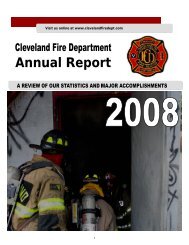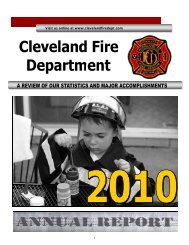SOP Manual - Cleveland Fire Department
SOP Manual - Cleveland Fire Department
SOP Manual - Cleveland Fire Department
- No tags were found...
You also want an ePaper? Increase the reach of your titles
YUMPU automatically turns print PDFs into web optimized ePapers that Google loves.
<strong>Cleveland</strong> <strong>Fire</strong> <strong>Department</strong><br />
Operations <strong>Manual</strong><br />
D. In order to comply with Federal regulations, all <strong>Cleveland</strong> <strong>Fire</strong> <strong>Department</strong> members shall wear<br />
the provided high visibility safety vests whenever they are working on or in close proximity to a<br />
roadway. This is to include all federal and state highways, county and city roads, and any<br />
secondary roads or streets. <strong>Fire</strong> department members should not wear these vests when they are in<br />
close proximity to flames, fire hazard or when there is a possibility of being exposed to hazardous<br />
materials.<br />
The safety vests that have been provided are tear-away type garments. Therefore all members,<br />
except for drivers that may not be wearing turnout coats, may have their assigned safety vests<br />
affixed to their turn-out coat prior to any calls. If there is a fire or known hazard or other situation<br />
that calls for the member to not wear the vest then the member can easily tear-away the safety<br />
vest. By virtue of their position, drivers do not have to have their safety vests affixed to their turn<br />
out gear, but are expected to wear the vest during any assignment where they are on or near a<br />
traffic area.<br />
E. Under no circumstance will a firefighter or Officer be on the fire ground of a working structure<br />
fire, vehicle accident or Hazmat incident without full protective clothing unless they are in the<br />
cold zone and not engaged in fire suppression. On ground fires while working under conditions of<br />
extreme heat and rough terrain, bunker pants, boots, and gloves are required, while coats and<br />
helmets may be optional if approved by the Incident Commander.<br />
F. Driver/Operators and/or Officers shall make sure all personnel are in full protective clothing and<br />
belted in the apparatus before it moves.<br />
G. When firefighters are already in fire apparatus without protective clothing, such as in returning<br />
from training sessions or other <strong>Fire</strong> <strong>Department</strong> activities, they shall don protective clothing en<br />
route if safety conditions permit or after arriving at the scene if conditions do not allow protective<br />
clothing to be donned en route.<br />
H. After arriving at an emergency scene and the Incident Commander determines that conditions are<br />
safe without some items of protective clothing, the Incident Commander may allow firefighters or<br />
Driver/Operators to remove these items. Conditions such as weather, type of incident, exposure,<br />
time of scene, and other factors should be considered by Incident Commanders when allowing<br />
firefighters to remove protective clothing. Safety of citizens and <strong>Fire</strong> <strong>Department</strong> personnel should<br />
always be of primary consideration.<br />
I. Under no circumstances shall any aspect of personal safety be sacrificed in order to increase the<br />
speed of emergency operations. Emergency operations shall not commence until all involved<br />
personnel have donned all necessary protective equipment.<br />
J. Full protective equipment including eye protection shall be worn by all personnel operating power<br />
tools, hydraulic tools, or forcible entry tools. Full protective equipment is also required for all<br />
personnel in the action circle at motor vehicle accidents.<br />
K. Command may use his/her discretion to regulate the wearing of full protective clothing in<br />
situations where it is necessary to operate in close quarters where full protective clothing cannot<br />
be worn.<br />
L. Gloves shall be worn at all times when hand tools, power tools, hose, ladders, or any other<br />
equipment is used that could cause injuries to the hands. This shall include all work details,<br />
maintenance operations, and training exercises.<br />
Effective: June 1, 1997 Revised: 5/14/2009 Page | 297<br />
Approved by: Chief Chuck Atchley




